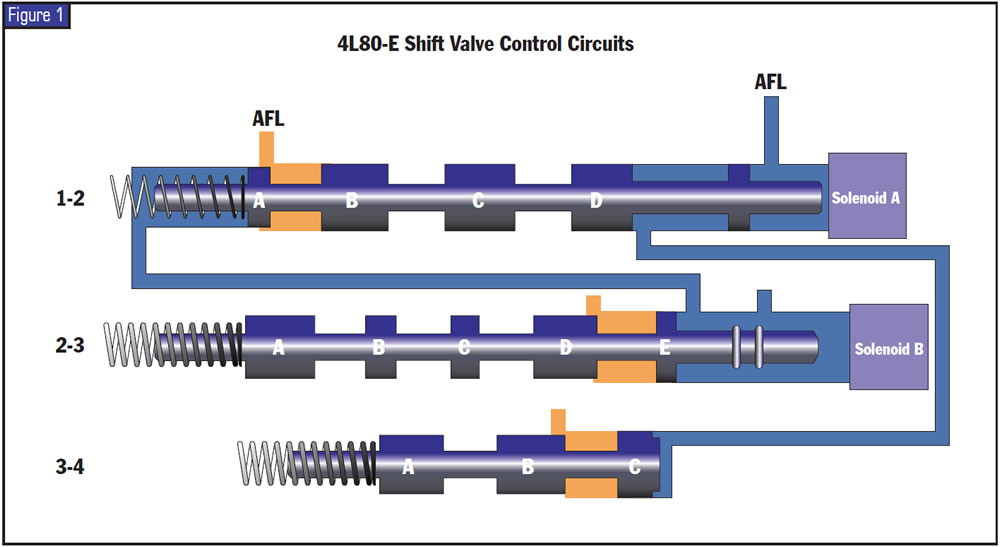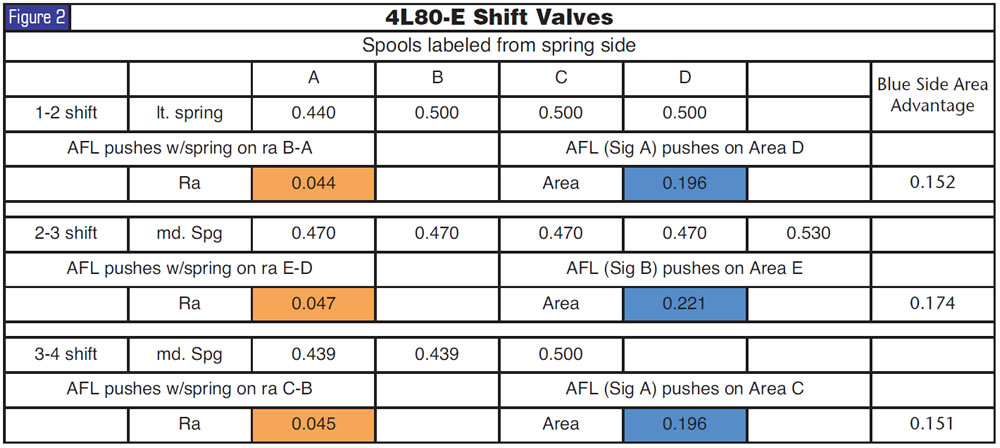
TASC Force Tips
- Author: Frank Biolsi
See the title? Say it to yourself. OK, one more time. Do you have it down yet? Would you say it out loud if I told you it just might save you hours of work and aggravation? Would you say it out loud if I told you it might help you fix one of those nasty little puzzlers that quite a few of you have already battled with but fixed the long, expensive way?
AFL stands for actuator feed limit and another fourth lost.
Perhaps you’ve already chased this on a 4L80-E or in a somewhat similar fashion on a 4L60-E. Here’s how badly it can go. You take in your buddy’s 4L80-E with converter codes and failsafe operation beginning to appear at normal mileage. Make it worse: It’s a good buddy, so you give him a break on the price. You scan the unit, drive it, do a careful rebuild, check TCC-related areas, put in a good converter, fill it with your preferred red fluid and reset the computer.
You’re happily patting yourself on the back after flawless 1-2 and 2-3 upshifts, and then it happens. What happened to 4th gear? Another fourth lost. Ah, must be failsafe, bad converter, bad computer. You spend the time, only to find nothing to condemn. You check the electronics, you use your controller, you check pressures, you do everything outside of the unit you can think of, and then you pull the pan and the body. Well, you’ve already replaced the solenoids. Let’s see, back through the fourth accumulator, recheck those shift valves and springs, air-check 4th clutch. Let’s be nice here and not have you pull the unit. You’ve got the idea. Another fourth lost. Try checking the AFL.
The AFL valve regulates actuator feed pressure to all three shift valves, to the pressure-control solenoid and to the 1-2 and 2-3 shift solenoids. The pressure is not fed to any clutches but is used to position the shift valves, which then will direct line pressure to the appropriate clutch. Many of you are already used to thinking actuator feed limit valve when you encounter wrong-gear starts or solenoid codes. That is absolutely correct.
Take a look at the simplified drawing of the three shift valves (Figure 1). The things shown in the drawing are the control factors. All three have a constant force trying to move the valve to the right: Each has a spring. Each also has actuator feed oil always available, as shown in orange. AFL oil pressure is directed between two different-sized spools. The resulting force, working with the spring force, is the orange pressure times the difference in area between the larger (right-hand) and smaller (left-hand) spools.

The right-hand ends of all three valves also receive the actuator feed oil. It is shown in blue here, but it comes from the same source as the orange. This blue-side oil is either exhausted or allowed to build pressure by the solenoids. That pressure acts on a much larger spool diameter than the same pressure shown in orange, so it wins the battle. If the pressure is above a certain point, it will overcome spring force as well and then stroke the valve to the left.
Notice that solenoid A does double duty by directing AFL (blue) pressure to both the 1-2 and 3-4 shift valves to stroke them left. Notice also that solenoid B does double duty by stroking the 2-3 shift valve left but also helping the spring force the 1-2 valve back to the right, even if solenoid A is on.
In this system, line pressure is always available for the shift valve to send to a clutch. If the shift valve is not in the intended position, it feeds the wrong clutch. For example, if AFL pressure was too low to overcome any of the shift-valve springs, all the valves would be to the right. That happens to be the desired valve position for second gear with OD range selected, where both solenoids are allowed to exhaust AFL pressure. The result of the low pressure in this case would be a 2nd-gear start.
AFL oil pressure is an offspring of line pressure. Like line pressure, it is not a constant pressure but one that rises and falls. It is limited to a maximum regulated pressure of 115 psi in high-line situations and will be less than line under all circumstances. AFL-related problems most likely would begin to occur in light-throttle or coast situations when line is already low. When AFL pressure drops to the range of 45-48 psi, problems begin to appear.
Let’s look at this deteriorating condition. AFL pressure is present but it is getting dangerously low. What could be the first appearance of an issue? Another fourth lost. Here’s why (see Figure 2.) The 1-2 shift valve’s “blue-side” area advantage is almost the same as the 3-4 shift valve’s area advantage, but it has to overcome a much lighter spring than the 3-4. It can overcome the light spring at a lower pressure and will not be the first of the two to fail to stroke its valve.

The springs on the 2-3 and 3-4 are very similar, and the force needed to overcome either is very close. The “blue-side” area advantage of the 2-3 is bigger than that of the 3-4, so at the same pressure, it applies more force to overcome the spring. The first valve to creep back as pressure begins to get critically low is 3-4. When it starts to move to the right, 4th-clutch feed is diminished. When it moves too far to the right, 4th-clutch feed is shut down. Another fourth lost.
Think about this the next time you get the unit that falls out of 4th or has no 4th at all. Consider it also if you do not yet have any 4th-gear complaints but the teardown reveals 4th-clutch distress. First, look at the familiar 4th-gear issues as you always did. Then remember AFL and AFL. Although it is not the only possibility for losing 4th, it is relatively easy to check but overlooked often enough to have given more than a few rebuilders a tough time.

Frank Biolsi, Sonnax technical-support manager, is a member of the TASC Force (Technical Automotive Specialties Committee), a group of recognized industry technical specialists, transmission rebuilders and Sonnax Industries Inc. technicians. © Sonnax 2005













